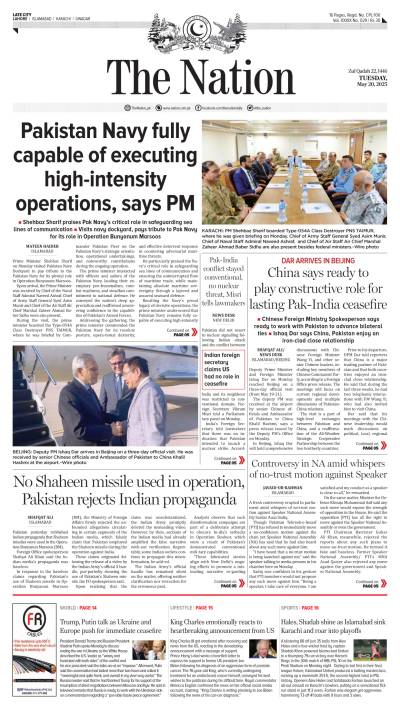Vice Admiral (Retd) Asaf Humayun, DG NCMPR)
How do you recognise the borders at sea? Is it marked like the land boundary? Who checks you when you enter a country’s sea frontier? Can you travel at sea without passport and visa even though you travel outside your own borders? This is quite confusing for the public. Perhaps World Maritime Day on 25th Sep 2014 provides a good opportunity to ponder over these questions.
In reality, the borders, ownership, territory and rights at sea are very different from land. One cannot draw or mark lines on long stretches of water. The question of sea frontiers has been debated for a long time and states acted unilaterally. It was settled when UN Convention on the Law of the Sea 1982 (Unclos III) came into force in 1994. Or was it settled? USA had cast a negative vote against the Convention. She remains the largest maritime nation that has not ratified Law of the Sea.
This international convention was a result of deliberations by 160 nations lasting over 9 years. In 1982, the Secretary General of United Nations categorised it as, “Possibly the most significant legal instrument of this century”. One hundred sixty five nations and European Union have joined the Convention and only few coastal states (including USA) do not abide by it. The Convention defines the extent of various maritime zones of a coastal state. It also lays down the rights and responsibilities of coastal and non-coastal countries concerning the use of world’s oceans. Therefore, a well-codified mechanism is now available to determine sea borders and for resolving disputes.
What is territorial sea? It is a belt of ocean adjacent to the land territory of a nation, seaward of rivers, most bays, narrow gulfs, lakes and ports. By tradition, the outer limit of coastal artillery (Cannon shot rule) determined the jurisdiction of a coastal state into sea. By 1800 century, the international practice was to claim three nautical miles wide territorial waters. When Pakistan became independent, this was the territorial sea limit from shoreline. In Dec 1966, Pakistan increased the width of territorial waters to 12 nautical miles (about 22.25 kilometres). Ten years later, Pakistani Government promulgated Territorial and Maritime Zones Act 1976. In 1997, Pakistan also declared a straight baseline along its coast. Now the territorial sea is measured 12 nautical miles into sea from the baseline. Using Unclos III, Pakistan has also demarcated its sea boundaries with Iran and Oman. Sea frontier with India in the East remains in dispute. Pakistan and India have held 12 rounds of discussions for deciding the exact sea frontier at Sir Creek. At times, the negotiations appear promising. However, there has been no progress since June 2012.
Pakistan has full sovereign rights in the territorial waters except that ships of other nations can use Pakistani waters for innocent passage. This is the international practice, as all states allow innocent passage through territorial waters. Unclos 1982 lays down the detailed definition of innocent passage. Passage of a ship is considered innocent when it does not threaten the safety and security of the coastal state or its ocean resources. No right of innocent passage exists in the airspace above the territorial sea. Thus, air borne platforms cannot traverse the territorial waters without coastal state’s permission.
According to Territorial and Maritime Zones Act 1976, Pakistan can suspend the right of innocent passage in specific areas of territorial sea. In all cases, ships have to make prior arrangements for entry into port areas and waters between baseline and the coast (internal waters). Countries do not allow right of innocent passage to foreign warships prior advance notification. Submarines have to navigate on surface showing their national flag. Of course, many powerful nations do not agree to such restrictions over innocent passage.
Adjacent to Pakistani territorial waters lies a contiguous zone whose breadth is 12 nautical miles or 24 nautical miles from baseline. The Territorial and Maritime Zones Act 1976 established the contiguous zone for Pakistan. In this zone custom, immigration, fiscal and sanitary regulations of Pakistan can be enforced. The contiguous zone is used as an area to check that national laws are obeyed in the territorial sea. In 1947, Pakistan’s fishery rights were limited to territorial waters only. The government increased the exclusive fishery zone in stages until implementation of Maritime Zones Act 1976. In Feb 1966, the limit of fishing zone was increased to 12 nautical miles and a fisheries conservation zone was established up to 100 nautical miles into sea. Later in 1973, a Gazette Notification extended the fishing zone to 50 nautical miles. Since 1976, Pakistan claims and enforces an Exclusive Economic Zone (EEZ) up to 200 nautical miles from the baseline.
In the EEZ, Pakistan claims and exercises sovereign rights over exploration and use of all living and non-living sources in water, on seabed and its subsoil. In 1990, Pakistan amended Exclusive Fishery Zone Rules. Now, the penalties specified in Exclusive Fishery Zone Act 1975 and Rules are applicable in the whole of EEZ.
Both Territorial and Maritime Zones Act 1976 and Unclos 1982 are watershed events for Pakistan. Before 1976, Pakistan had notified 12 nautical miles as territorial sea limit and 100 nautical mile fishery conservation zone. Thus, in one sweep Pakistan claimed Exclusive Economic Zone up to 200 nautical miles. Unclos 1982 supports this claim. Now Pakistan has rights over nearly 240,000 sq km of EEZ, which is slightly smaller than the province of Balochistan. Additionally Pakistan’s claim for Continental Shelf will add about 50,000 sq km to the exploitable seabed and subsoil resources.
Do we now know the answers to the questions posed in the beginning of this article? One cannot see the line of frontier in water. It is a claim, marked on sea maps. Travel documents are not required for a voyage at sea unless you decide to enter a country’s contiguous zone or territorial sea. If you intend to remain in international waters and don’t intend to break the law, simple identity card will suffice; so bon voyage.
Wednesday, May 21, 2025
Pakistan’s maritime borders

5:43 PM | May 20, 2025
5:43 PM | May 20, 2025
-
Lahore emerges among safest global cities in Numbeo 2025 index
-
Lahore emerges among safest global cities in Numbeo 2025 index
-
India’s suspension of Indus Water Treaty legally baseless
-
Seventh polio case reported in Pakistan amid nationwide vaccination drive
-
Pakistan reports sixth polio case of 2025
-
PTA begins issuing VPN licences to regulate usage
The Wider War
May 20, 2025
Margalla on Fire
May 20, 2025
Defeated and Depressed
May 20, 2025
Regional Reset
May 19, 2025
Peak Potential
May 19, 2025
Golf or Water
May 21, 2025
Performing CPR
May 21, 2025
Lack of Sign Language Teaching
May 21, 2025
State of War & Public Awareness
May 21, 2025
Indian Attack
May 21, 2025
ePaper - Nawaiwaqt
Nawaiwaqt Group | Copyright © 2025





